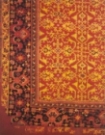|
Colossal carpets
Daniel Shaffer* on the events in Istanbul that breathed new life into one of the world’s great carpet collection.
 In the heart of old Sultanahmet, facing Ayasofya and the Blue Mosque across the Byzantine Hippodrome, is the fine palace built for Ibrahim Pasha, Suleyman the Magnificent’s grand vizier. Here the Turkish and Islamic Arts Museum (TIEM) proudly holds what is arguably the greatest collection of historical oriental carpets anywhere in the world. The museum is a Mecca for enthusiasts and scholars alike, but far too little appreciated by the public at large. In the heart of old Sultanahmet, facing Ayasofya and the Blue Mosque across the Byzantine Hippodrome, is the fine palace built for Ibrahim Pasha, Suleyman the Magnificent’s grand vizier. Here the Turkish and Islamic Arts Museum (TIEM) proudly holds what is arguably the greatest collection of historical oriental carpets anywhere in the world. The museum is a Mecca for enthusiasts and scholars alike, but far too little appreciated by the public at large.
The bulk of the collection of more than 1,600 pieces consists of Ottoman-period rugs and carpets. Large and small, courtly and rustic, such carpets were woven in imperial ateliers and commercial urban and cottage workshops, as well as on domestic looms all over Anatolia, between the 13th and 18th centuries, and were traditionally given by the rich and powerful, and by simple villagers, as pious donations (vakıf) to mosques and tombs the length and breadth of the Ottoman Empire.
The TIEM collection is just one part of the incredible treasury of woven art, an unparalleled account of Turkey’s cultural heritage gathered and safeguarded in the 20th century by the Vakıflar (Pious Foundations) and the ministries of the secular Turkish State.
The jewel that underpins the TIEM’s holding is a group of massive, boldly conceived pre-Ottoman carpets and fragments usually attributed to Seljuk central Anatolia, having been found in the early 13th-century Alaeddin Keykubad complex in Konya and the Eşrefoğlu Mosque in nearby Beyşehir. Two of the grandest of these carpets, with their austere but complex geometries, were chosen for the memorable Turks exhibition at London’s Royal Academy in 2005.
In April 2007, for the International Conference on Oriental Carpets (ICOC) in Istanbul, the TIEM unveiled an unforgettable temporary exhibition in which the already incomparable semi-permanent arrangement that dominates the museum’s galleries – including the Konya Seljuk carpets and a wide array of Ottoman period rugs and large carpets (so-called “Holbeins” and “Lottos” and star and medallion Ushaks), prayer rugs and safs (multiple-niche mosque carpets) – was supplemented by spectacular pieces never before displayed.
 In addition to its Turkish carpets treasures – which were augmented in the exhibition by a good number of seldom-seen but spectacularly bold and beautiful early Anatolian village rugs – the TIEM has a very significant group of grand 16th-to18th-century Persian and Caucasian classical carpets, luxury imports collected from mosques along the trade route connecting Asia Minor to the East. It was these imposing weavings that were the most immediately dramatic temporary exhibits. In addition to its Turkish carpets treasures – which were augmented in the exhibition by a good number of seldom-seen but spectacularly bold and beautiful early Anatolian village rugs – the TIEM has a very significant group of grand 16th-to18th-century Persian and Caucasian classical carpets, luxury imports collected from mosques along the trade route connecting Asia Minor to the East. It was these imposing weavings that were the most immediately dramatic temporary exhibits.
From Persia there were two Kerman “vase” carpets, one a sparkling large 16th-century fragment, as well as a Khorasan “shrub” carpet and two magnificent chahar bagh garden carpets from northwestern Iran. And from the Caucasus, the TIEM curators had chosen a varied dozen of extraordinary “dragon”, “blossom” and “palmette” carpets, some of them unfamiliar variants on well-known themes.
The special six-month display was made possible by a major fundraising initiative from ICOC. A new conservation facility was created in which 30 conservators spent eight months cleaning and mounting 119 carpets.
As part of the preparation for the hugely successful Istanbul conference in April, the chairman of the local committee, Mehmet Çetinkaya, and his colleagues on the ICOC international committee, seeing an exceptional opportunity to increase appreciation and awareness of historic carpets and to encourage the stewardship of existing museum collections, launched an appeal via their websites (icoc-istanbul.org and icoc-orientalrugs.org).
In addition to raising $25,000 from North American individuals, the website appeal was spotted by the Massachusetts-based Turkish Cultural Foundation**, which promptly proposed to donate up to $250,000 for the cleaning and conservation project, with the important proviso that the Turkish government match this amount.
After several meetings with the ministry of tourism and culture, this was agreed and work began, with Çetinkaya organising the project and liaising with the TIEM director, Seracettin Şahin, and the curator, Gönül Tekeli.
The result has been a triumph: the cleaning, conservation and presentation of many historic carpets; a feast for the eyes and minds of a dedicated following; and eye-opener for the general public. Much kudos to all.
* Daniel Shaffer is executive editor of HALI Magazine (www.hali.com) Daniel.shaffer@hali.com
** The Turkish Cultural Foundation, which underwrote the TIEM carpets’ conservation, holds lectures in Washington DC, Boston and Istanbul and conducts cultural tours of Turkey: www.turkishculturalfoundation.org
Source: Daniel Shaffer, Cornucopia Issue 39, 2008, p. 15
URL: http://www.cornucopia.net/
|